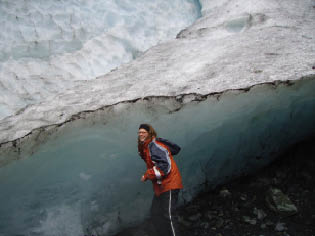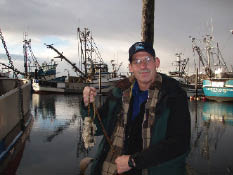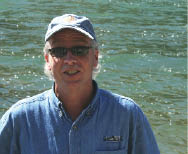Thoreau's Legacy (5 page)
Authors: Richard Hayes

For the Love of Alaskan Ice
Susan Carol Stein
EVERYONE SHOULD LICK A GLACIER. IT TASTES A little bit like dinosaurs and looks a little bit like God, whatever that is. Take a good, long lick. You are just one person meaning no harm.
Everyone should
hug a glacier
with bare hands spread wide.
Go on, do it. Run up to it with your arms open, as if it were your favorite grandma. Push your hands into the ice. Feel the old, old cold pulling away even as you make contact. It’s not your imagination. The loss is subtle but sincere. Stare at the thin line of black rock between your boots and the glacier’s edge. No one has seen that sliver of earth before this moment. No one. It’s been buried, protected, unexamined. You begin to feel responsible for exposing the hidden skull of the planet.
How could you know, living all your life in the bellies of cities, that you would fall in love with Alaskan ice? This beautiful blueberry Slurpee that stretches across the top of the earth is changing you.
You learn the size of your carbon footprint and begin to minimize it. You telecommute as often as possible, walk wherever you can. You grow your own organic veggies, buy local, and avoid franchised food. You plant trees and flowers that attract bees and birds. You notice that wildlife now throngs to your healthy back yard, your tiny spot of earth. You use earth-friendly cleaning products and you recycle. You cut plastic out of your life whenever possible. You share your bath with someone special. Conservation is loads more fun than you ever imagined.
You put on another sweater and lower your thermostat. You join the Sierra Club. You pay close attention to what businesses, scientists, and politicians are doing to shift gears, lower the heat, slow down the melt, take full responsibility, and protect what is left. It’s time.
Don’t feel guilty. Don’t blame anyone or blow hot air—we don’t need more of that. And don’t be overwhelmed, don’t panic. These are all petty indulgences. Rather, hold the image of a healthy glacier in your heart and the taste of ancient ice on your tongue. It will change you and gently lead you to make change.
Susan Carol Stein
owns a fair-trade Internet business that donates its net profits to global organizations that aid women and children. She lives in Seattle, where she also volunteers to protect indigenous land in Siberia.

The author at Exit Glacier, Kenai Fjords National Park, Alaska. Photo by Jackie Stratton.
Through a
Sailor’s Eyes
Edward C. Brainard II
AS A SAILOR, I VIEW THE WORLD FROM THE SEA, gaining a perspective often lost on land. I feel very close to the sea, where life was created, for my blood runs deep with the balance of its salts.
I have made many Atlantic crossings in small yachts and have seen many storms. You learn to be prepared, to make sure that your yacht is well founded. At the mercy of nature, you develop a profound respect for her power.
You are
in her realm,
and after each storm you are thankful to have survived.
You have been given another chance, and deep inside yourself you promise to show her respect and a willingness to give back all she has done for you.
Many wonderful memories come to me. During a dark, foggy night I saw the phosphorescent trails of a mother dolphin and her baby flowing abeam without effort, ribbons of undulating fire. In the morning the two dolphins were still there. They seemed content to be at our side. We developed a fondness for this marvel, a feeling of closeness and respect, a bond that they would be safe in the future.
In 1986 I was planning my first double-handed transatlantic OSTAR race with the help of a meteorologist. We were deciding on a route from Plymouth, England, to Newport, Rhode Island, for the next summer. Normally we see Mercator projections as viewed from the equator, but I spotted one projection looking down from the North Pole. Like magic, I could see three very large storms equally spaced around the globe above the mid-latitudes. The system looked like the planetary gear in an automobile. That one image suddenly made me realize that a storm is not just an isolated event, it is part of a marvelous weather machine driven by the heat of the sun. Everything is interrelated.
The surface temperature of the sea is rising, and violent hurricanes are increasing. Higher ocean acidity threatens the development of shells and corals. Sea level is rising. We know we will see major shifts in weather patterns and ocean currents. Although the future is not clear, there will certainly be immense changes that will have profound effects on future generations. There will be major dislocations of human populations and of all life on our planet. There will be no safe haven.
Only the wise use of our environment and resources will ensure that we can continue. Our efforts to adjust to change will strengthen our role as stewards of our planet, helping to preserve this world so that future generations can enjoy seeing the rising sun at sea, with gales to keep us on our guard. A well-prepared yacht has a much better chance of surviving. Using our planet and its resources intelligently will similarly give us all a better chance of survival.

Edward C. Brainard II
, an inventor and retired executive whose previous company makes oceanographic and environmental instruments, lives in Marion, Massachusetts. He is a Corporation Member of the Woods Hole Oceanographic Institution and a member of the Cruising Club of America.
Chukchi Sea
Ice-Out
Bruce Wright
I LIVE IN ALASKA, AND MY CLIMATE-CHANGE RESEARCH projects are devoted to understanding changes in the distribution of harmful algal blooms, paralytic shellfish poisoning, and domoic acid. I also study highly migratory sharks (salmon sharks and great whites). However, in June 2007 I was teaching a 7 Generations environmental education class in Wainwright, an Inupiat village of about 550 people on the Chukchi Sea. Wainwright is a whaling community and is very connected to the sea for both spiritual and physical sustenance.
My classroom was a hall in the community building, about a hundred meters from the beach, but no waves pounded the shoreline because it was sealed in ice. After class I had plenty of daylight to go exploring; in June the sun is up twenty-four hours a day. Two Inupiat boys playing in the sand above the ice-covered sea asked who I was and what I was doing. We quickly became friends and talked about our communities; mine was Wasilla. I asked about the boats and the meat piled on the ice. They said it was shares of whale meat and muktuk (whale skin and fat) that the community elders had not yet picked up, and they convinced me we should go investigate. I brought my pocket knife, and the three of us shared a little bit of muktuk.
During class on my third day in Wainwright, a man opened the door and excitedly said, “The ice is going out! The ice is going out!” Sure enough, half an hour later, while on break, the entire class walked to the beach and saw that the sea ice had retreated miles offshore. I was especially surprised because
there was no wind; the ice
seemed to be moving
by some strong unseen force.
By the end of class the sea ice was no longer visible; it was at least twenty miles out. So I went to my room to unpack the folding fishing rod that always accompanies me in my travels and returned to the shore of the Chukchi Sea to fish.
After a while an elder came up behind me and silently watched for about five minutes, then asked, “Catch anything?” I waited a minute, then responded, “No.” After making five more casts, I asked if there were any fish here. Five minutes went by while the old Eskimo thought of an appropriate response. Finally he said, “Don’t know.” Then, after another brief wait, “You are the first human being to fish here in June. Ever.”
In 2007 the sea ice at Wainwright went out six weeks earlier than had ever been recorded in local knowledge.

Bruce Wright
lives and works in Alaska as a senior scientist for the Aleutian Pribilof Islands Association and executive director of the nonprofit Conservation Science Institute. When not spending time with his family, he enjoys being in the wilderness, where he is regularly close to wolves, bears, and moose.
Climate Change and Creature Comforts
Terril L. Shorb
IN THE HIGH DESERT OF THE AMERICAN SOUTHWEST, we know what global climate change sounds like. It is the sound of many tongues lapping. When we moved to central Arizona seventeen years ago, one appealing feature was the presence of wild javelina, deer, foxes, coyotes, tarantulas, and a rainbow of birds, from scrub jays to roadrunners. We put out a wet welcome mat in the form of a shallow steel pan of water, which was used mostly by birds for bathing. The pan was usually three-quarters full the next morning.
In the past decade, the “pan index” has changed. Our central Arizona highlands typically receive nearly twenty inches of precipitation annually, but in many of the past ten years we have received significantly less.
Foothills and grasslands once glittered with natural catch basins year-round;
most are now dry.
It is possible to wander twenty thousand square miles of central and northern Arizona and scarcely get your boots wet.
While some pundits wag their tongues to deny that humans are a causative factor in global climate change, the tongues of the wild creatures in our midst lap at our water pan, which now shows up empty most mornings. We put out more pans. By day javelina sip daintily, and dozens of juncos and white-crowned sparrows perch on the rim, bending low to dip thirsty beaks. At night we have seen a white-throated desert pack rat slake its thirst. Desert hares, gray foxes, a coyote, wasps, beetles, and other wild creatures are regular visitors to the pans.
Another visible effect of the prolonged drought is the precarious drop in a local aquifer, drying up springs that once trickled over parched ground across the region. And that brings us back to the tiny oasis in our back yard. We realize that we must offset the water we provide for wildlife by conserving water elsewhere. We have installed low-flush toilets. We consolidate household washing chores. When exotic trees and shrubs planted by previous owners succumbed to drier conditions, we replaced them with native species that provide forage and shelter for native creatures.
One unexpected form of resource conservation is that we drive fewer miles for entertainment or purchase of “things” for the household, because we love to stay home and observe the never-ending drama of local wildlife. There is a direct correlation between our heightened happiness from interacting with nature and the decline in our material consumption.
Conserving water is a small sacrifice compared to the enormous joy of seeing wild creatures slake their thirst at the little steel water holes. Looking out for other-than-human beings in our natural neighborhood is our way of responding positively to global climate change. The presence of these critters is integral to our daily life. Our small act moderates our consuming ways and gives new meaning to the phrase “providing for creature comforts.”

Terril L. Shorb
grew up on ranches and farms in the northern Rockies and now teaches at Prescott College in Prescott, Arizona. He cofounded and directs the college’s Sustainable Community Development Program.
